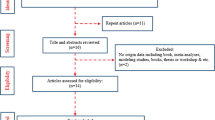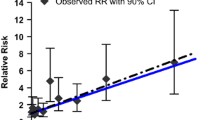Abstract
Aim
To investigate the exposure-risk relationship for occupational chromium (VI) exposure and lung cancer in order to establish exposure limits.
Methods
We systematically searched for studies reporting on occupational Cr(VI) exposure and cancers of the respiratory tract. To be included, studies needed to provide data for more than one level of occupational Cr(VI) exposure, adequately consider the confounder smoking and be of adequate methodological quality. Because direct genotoxicity was considered the predominant mechanism of carcinogenesis of Cr(VI), linear models were applied in order to fit risk data. Relative risks were calculated based on these linear regression models and then used to estimate excess absolute risks.
Results
Five studies of two cohorts of chromium production workers in Baltimore, Maryland, and Painesville, Ohio, were included. Based on different estimates for the exposure effect, the absolute excess risk was found to be “acceptable” (less than 4 per 10,000 according to the German Committee on Hazardous Substances, “AGS”) at a Cr(VI) concentration of 0.1 μg/m3, and became “intolerable” (more than 4 per 1,000) beyond a Cr(VI) concentration of 1 μg/m3.
Conclusion
Occupational exposure limits for Cr(VI) based on excess absolute risks can be derived from published data identified by a systematic literature review.





Similar content being viewed by others
References
ACGIH (American Conference of Industrial Hygienists) (2004) Chromium and inorganic compounds; Chromium(VI), water-soluble fume
AGS (2008) Announcement 910 June 2008. Announcement on hazardous substances, risk figures and exposure-risk relationships in activities involving carcinogenic hazardous substances. URL http://www.baua.de/en/Topics-from-A-to-Z/Hazardous-Substances/TRGS/pdf/Announcement-910.pdf?__blob=publicationFile&v=2. Accessed 14 Aug 2011
Alderson M, Rattan N, Bidstrup L (1981) Health of workmen in the chromate-producing industry in Britain. Br J Ind Med 38:117–124
ATSDR (Agency for Toxic Substances & Diseases Registry) (2000) URL http://www.atsdr.cdc.gov. Accessed 14 Apr 2011
Birk T, Mundt KA, Dell LD, Luippold RS, Miksche L, Steinmann-Steiner-Haldenstaett W, Mundt DJ (2006) Lung cancer mortality in the German chromate industry, 1958–1998. J Occup Environ Med 48:426–433
Bukowski JA, Goldstein MD, Johnson BB (1991) Biological markers in chromium exposure assessment confounding variables. Arch Environ Health 46:230–236
CASP (Critical Appraisal Skills Programme of the British NHS Appraisal Tools) (2008) URL http://www.phru.nhs.uk/Pages/PHD/CASP.htm. Accessed 14 Apr 2011)
Crispo A, Brennan P, Jöckel KH, Schaffrath-Rosario A, Wichmann HE, Nyberg F, Simonato L, Merletti F, Forastiere F, Boffetta P, Darby S (2004) The cumulative risk of lung cancer among current, ex- and never-smokers in European men. Br J Cancer 91:1280–1286
Crump C, Crump K, Hack E, Luippold R, Mundt K, Liebig E, Panko J, Paustenbach D, Proctor D (2003) Dose-response and risk assessment of airborne hexavalent chromium and lung cancer mortality. Risk Anal 23:1147–1163
De Flora S, Bagnasco M, Serra D, Zanacchi P (1990) Genotoxicity of chromium compounds. A review. Mutat Res 238:99–172
Deutsche Forschungsgemeinschaft (DFG) (ed) (2012) MAK- und BAT-Werte-Liste 2012: maximale Arbeitsplatzkonzentrationen und Biologische Arbeitsstofftoleranzwerte, vol 48. Wiley-VCH, Weinheim
Gerin M, Fletcher AC, Gray C, Winkelmann R, Boffetta P, Simonato L (1993) Development and use of a welding process exposure matrix in a historical prospective study of lung cancer risk in European welders. Int J Epidemiol 22(Suppl 2):S22–S28
Gibb HJ, Lees PS, Pinsky PF, Rooney BC (2000) Lung cancer among workers in chromium chemical production. Am J Ind Med 38(2):115–126
Globocan (2008) Cancer incidence, mortality and prevalence worldwide in 2008. URL http://globocan.iarc.fr/. Accessed 19 Mar 2012
Goldbohm RA, Thielemans LJP, Heederik D, Rubingh CM, Dekkers S, Willems MI, Kroese ED (2006) Risk estimation for carcinogens based on epidemiological data: a structured approach, illustrated by an example on chromium. Reg Tox Pharm 44:294–310
International Agency on Research on Cancer (IARC) (1990) IARC monographs on the evaluation of carcinogenic risks to humans, chromium, nickel and welding, 49, Lyon
Jones ME, Swerdlow AJ (1998) Bias in the standardized mortality ratio when using general population rates to estimate expected number of deaths. Am J Epidemiol 148:1012–1017
Liberati A, Altman DG, Tetzlaff J, Mulrow C, Gøtzsche PC, Ioannidis JP, Clarke M, Devereaux PJ, Kleijnen J, Moher D (2009) The PRISMA statement for reporting systematic reviews and meta-analyses of studies that evaluate health care interventions: explanation and elaboration. PLOS 6:1–28
Luippold RS, Mundt KA, Austin RP, Liebig E, Crump C, Crump K, Proctor D (2003) Lung cancer mortality among chromate production workers. Occup Environm Med 60:451–457
Manusco TF (1997a) Chromium as an industrial carcinogen: part I. Am J Ind Med 31:129–139
Manusco TF (1997b) Chromium as an industrial carcinogen: part II. Chromium in human tissues. Am J Ind Med 31:140–147
Mattioli S, Zanardi F, Baldasseroni A, Schaafsma F, Cooke RMT, Mancini G, Fierro M, Santangelo C, Farioli A, Fucksia S, Curti S, Violante FS, Verbeek J (2010) Search strings for the study of putative occupational determinants of disease. Occup Environ Med 67:436–443
Morfeld P, McCunney RJ (2010) Bayesian bias adjustment of the lung cancer SMR in a cohort of German carbon black production workers. J Occup Med Tox 5:23
SIGN (Scottish Intercollegiate Guidelines Network) (2008) URL http://www.sign.ac.uk/methodology/checklists.html. Accessed 14 Apr 2011
Park RM, Stayner LT (2006) A search for thresholds and other nonlinearities in the relationship between hexavalent chromium and lung cancer. Risk Anal 26:79–88
Park RM, Bena JF, Stayner LT, Smith RJ, Gibb HJ, Lees PS (2004) Hexavalent chromium and lung cancer in the chromate industry: a quantitative risk assessment. Risk Anal 24:1099–1108
Robert Koch Institut (RKI) (2012) Krebs in Deutschland 2007/2008. Gesundheitsberichterstattung des Bundes. RKI 2012. http://edoc.rki.de/documents/rki_fv/re2vZ21t28Ir8Y/PDF/22aJOdYnmXV0I.pdf. Accessed 19 Mar 2012
SCOEL (2004) Recommendation from the scientific committee on occupational exposure limits: risk assessment for hexavalent chromium, SCOEL/SUM/86, December 2004
Steenland K, Deddens JA (2004) A practical guide to dose-response analyses and risk assessment in occupational epidemiology. Epidemiology 15:63–70
Steenland K, Loomis D, Shy S, Simonsen N (1996) Review of occupational lung carcinogens. Am J Ind Med 29:317–324
Takahashi K, Okubo T (1990) A prospective study of chromium plating workers in Japan. Arch Environm Health 45:107–111
R Development Core Team (2011) R: a language and environment for statistical computing. R foundation for statistical computing, Vienna, Austria. URL http://www.r-project.org/
US EPA (1998) Toxicological Review of hexavalent chromium (CAS No. 18540-29-9) in support of summary information on the Integrated Risk Information System (IRIS). US Environmental Protection Agency. URL http://www.epa.gov/iris/toxreviews/0144tr.pdf. Accessed 9 Oct 2012
WHO (2000) Air quality guidelines, 2nd edn. WHO Regional Office for Europe, Copenhagen
Acknowledgments
The authors thank the German Federal Institute for Occupational Safety and Health for funding.
Conflict of interest
The authors declare that they have no conflict of interest.
Author information
Authors and Affiliations
Corresponding author
Rights and permissions
About this article
Cite this article
Seidler, A., Jähnichen, S., Hegewald, J. et al. Systematic review and quantification of respiratory cancer risk for occupational exposure to hexavalent chromium. Int Arch Occup Environ Health 86, 943–955 (2013). https://doi.org/10.1007/s00420-012-0822-0
Received:
Accepted:
Published:
Issue Date:
DOI: https://doi.org/10.1007/s00420-012-0822-0




